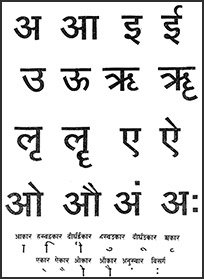Vivritti, Vivṛtti: 9 definitions
Introduction:
Vivritti means something in Hinduism, Sanskrit. If you want to know the exact meaning, history, etymology or English translation of this term then check out the descriptions on this page. Add your comment or reference to a book if you want to contribute to this summary article.
The Sanskrit term Vivṛtti can be transliterated into English as Vivrtti or Vivritti, using the IAST transliteration scheme (?).
In Hinduism
Vyakarana (Sanskrit grammar)
Source: Wikisource: A dictionary of Sanskrit grammar1) Vivṛtti (विवृत्ति).—Separation of the two vowels which were euphonically combined into one; the hiatus or position of two vowels near each other; cf. विवृत्तिः स्वरयोरसंधिः (vivṛttiḥ svarayorasaṃdhiḥ);
2) Vivṛtti.—The interval between two vowels placed near each other; cf. स्वरयो-रनन्तरयोरन्तरं विवृत्तिः (svarayo-ranantarayorantaraṃ vivṛttiḥ) V. Pr. I.119; cf. also संहितायां यत्स्वरयोरन्तरं तद्विवृत्तिसंज्ञं स्यात् (saṃhitāyāṃ yatsvarayorantaraṃ tadvivṛttisaṃjñaṃ syāt) Uvvaṭa on R. Pr. II.1. This interval is one mātrā according to the Taittirīya Prātiśākhya, while it is only half-a-mātrā according to the Ṛktantra and the Ṛk-Prātiśākhya; cf. T. Pr. XXII. 13; R. T. 3५. See विराम (virāma).

Vyakarana (व्याकरण, vyākaraṇa) refers to Sanskrit grammar and represents one of the six additional sciences (vedanga) to be studied along with the Vedas. Vyakarana concerns itself with the rules of Sanskrit grammar and linguistic analysis in order to establish the correct context of words and sentences.
Languages of India and abroad
Sanskrit dictionary
Source: DDSA: The practical Sanskrit-English dictionaryVivṛtti (विवृत्ति).—f.
1) Turning round, whirling, revolution. मनोऽस्य जह्रुः शफरीविवृत्तयः (mano'sya jahruḥ śapharīvivṛttayaḥ) Kirātārjunīya 4.3;7.12.
2) Going asunder; संवाता मुहुरनिलेन नीयमाने दिव्यस्त्रीजघनवरांशुके विवृत्तिम् (saṃvātā muhuranilena nīyamāne divyastrījaghanavarāṃśuke vivṛttim) Kirātārjunīya 7.14.
3) Expansion, development; विराजमतपत् स्वेन तेजसैषां विवृत्तये (virājamatapat svena tejasaiṣāṃ vivṛttaye) Bhāgavata 3.6.1.
2) (In gram.) A hiatus.
Derivable forms: vivṛttiḥ (विवृत्तिः).
Source: Cologne Digital Sanskrit Dictionaries: Shabda-Sagara Sanskrit-English DictionaryVivṛtti (विवृत्ति).—f.
(-ttiḥ) 1. Whirling, turning round. 2. A hiatus, (in gram.) E. vi, vṛt to be, aff. ktin .
Source: Cologne Digital Sanskrit Dictionaries: Benfey Sanskrit-English DictionaryVivṛtti (विवृत्ति).—[vi-vṛt + ti], f. Turning round, rolling, whirling, tumbling.
Source: Cologne Digital Sanskrit Dictionaries: Cappeller Sanskrit-English DictionaryVivṛtti (विवृत्ति).—[feminine] expansion; hiatus ([grammar]).
Source: Cologne Digital Sanskrit Dictionaries: Monier-Williams Sanskrit-English Dictionary1) Vivṛtti (विवृत्ति):—[=vi-vṛtti] [from vi-vṛtta > vi-vṛt] f. going asunder, opening, expansion, development, [Kirātārjunīya; Bhāgavata-purāṇa]
2) [v.s. ...] turning round, revolution, rolling, whirling, tumbling, [Kirātārjunīya]
3) [v.s. ...] (in gram.) the opening of two vowels upon each other without blending, hiatus, [Prātiśākhya]
Source: Cologne Digital Sanskrit Dictionaries: Yates Sanskrit-English DictionaryVivṛtti (विवृत्ति):—(ttiḥ) 2. f. Turning round, whirling.
[Sanskrit to German]
Sanskrit, also spelled संस्कृतम् (saṃskṛtam), is an ancient language of India commonly seen as the grandmother of the Indo-European language family (even English!). Closely allied with Prakrit and Pali, Sanskrit is more exhaustive in both grammar and terms and has the most extensive collection of literature in the world, greatly surpassing its sister-languages Greek and Latin.
Kannada-English dictionary
Source: Alar: Kannada-English corpusVivṛtti (ವಿವೃತ್ತಿ):—[noun] the tendency of acting in accordance with one’s whim (without reason and without thinking of the consequences).
Kannada is a Dravidian language (as opposed to the Indo-European language family) mainly spoken in the southwestern region of India.
See also (Relevant definitions)
Starts with: Vivrittimukha, Vivrittipurva.
Ends with: Antahpadamvivritti, Bijavivritti, Svaravivritti.
Full-text: Vaivritta, Vivrittipurva, Vivrittimukha, Bijavivritti, Svarantara, Anusritavatsa, Vivrittyabhipraya, Chandovivriti, Samanavarna, Anunasikopadha, Antahpadamvivritti, Nihsanga, Dvishamdhi, Kshemaraja, Dvisandhi, Vyavritti, Virama.
Relevant text
Search found 6 books and stories containing Vivritti, Vivṛtti, Vivrtti, Vi-vritti, Vi-vṛtti, Vi-vrtti; (plurals include: Vivrittis, Vivṛttis, Vivrttis, vrittis, vṛttis, vrttis). You can also click to the full overview containing English textual excerpts. Below are direct links for the most relevant articles:
History of Indian Medicine (and Ayurveda) (by Shree Gulabkunverba Ayurvedic Society)
Chapter 10 - The Pupils of Atreya < [Part 1 - The History of Medicine in India]
Bodhisattvacharyavatara (by Andreas Kretschmar)
Bibliography Of Sūtras, Tantras And śāstras
Translator’s Introduction < [Introduction Text]
The Brahmanda Purana (by G.V. Tagare)
Chapter 32 - Yugas and classes of people: lineage of sages < [Section 2 - Anuṣaṅga-pāda]
Bhagavad-gita-rahasya (or Karma-yoga Shastra) (by Bhalchandra Sitaram Sukthankar)
Consciousness in Gaudapada’s Mandukya-karika (by V. Sujata Raju)
Shri Gaudiya Kanthahara (by Srila Bhaktisiddhanta Sarasvati)